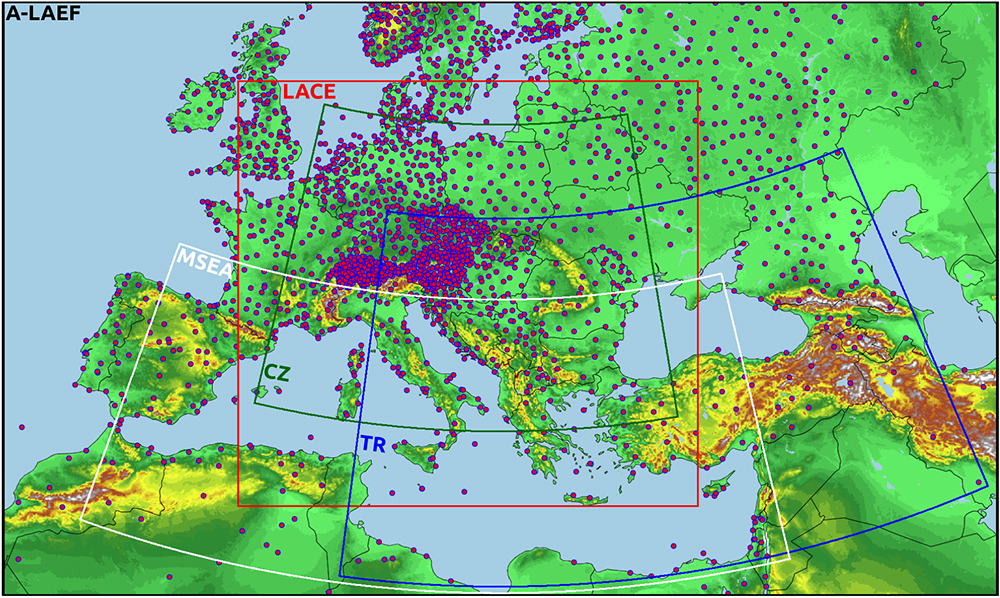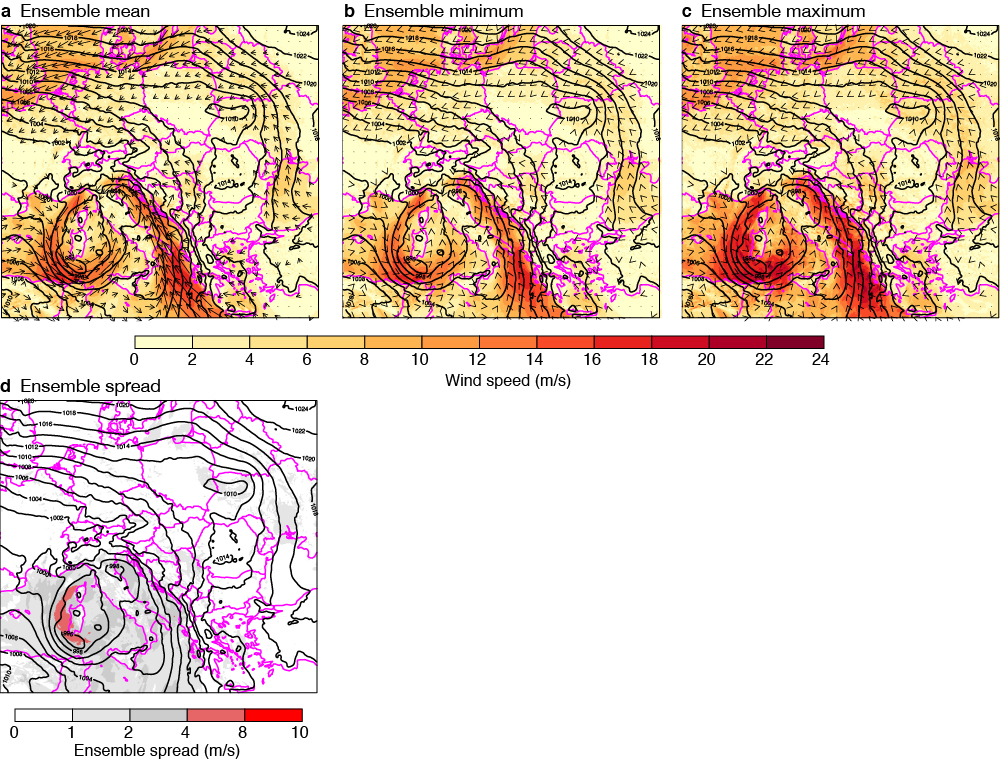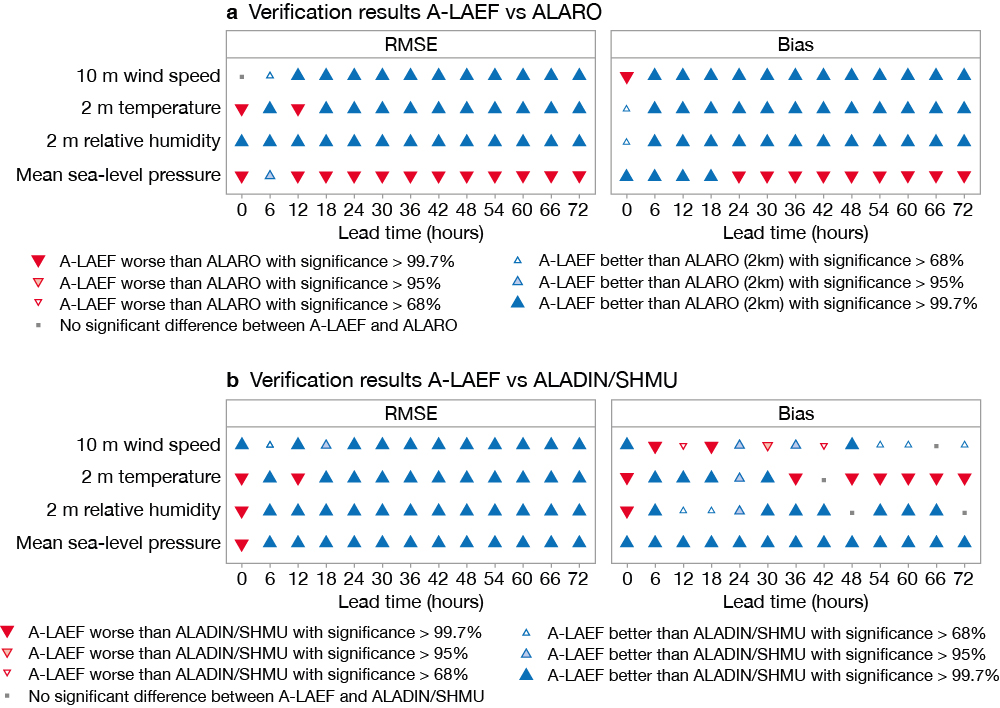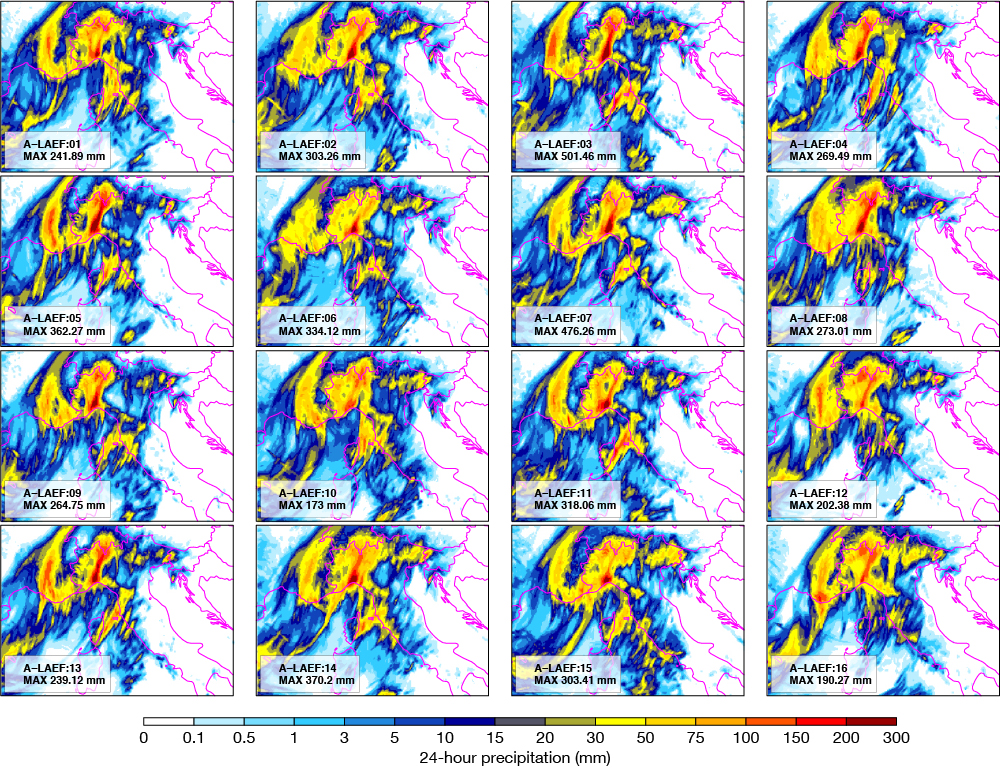In July 2020, a new mesoscale ensemble prediction system, A-LAEF (ALARO – Limited Area Ensemble Forecasting), became operational under the time-critical framework for Member State applications, running on ECMWF’s high-performance computing facility (HPCF). A-LAEF is a successor of the former regional ALADIN-LAEF ensemble running at ECMWF as a common ensemble prediction system (EPS) project of the RC LACE (Regional Cooperation for Limited-Area modelling in Central Europe) consortium (Austria, Croatia, Czech Republic, Hungary, Poland, Romania, Slovakia, Slovenia) since 2011 (Wang et al., 2011).
A‑LAEF is different from its predecessor, both technically and scientifically. It is built around a completely new scripting system under the ecFlow client/server workflow manager. Its spatial density of grid points is 14 times higher than in the version of 2011 and five times higher than in that version’s last upgrade, which was operational until 2020. The process of transformation from ALADIN-LAEF to A‑LAEF is documented in Belluš at al. (2019) and Belluš (2019).
A‑LAEF makes use of native uncertainty simulations of the initial surface and atmospheric conditions, and of the model physics. The global ensemble of ECMWF prescribes uncertainties in lateral boundary conditions. The new A‑LAEF system aims for reliable probabilistic forecasts of meso-synoptic scales up to three days ahead. Within that time range it can outperform deterministic models that have a similar or even higher spatial resolution. We demonstrate this statement by the statistical verification of A‑LAEF against the operational deterministic model ALADIN/SHMU and the experimental non-hydrostatic ALARO model with 2 km horizontal resolution running in a dynamical adaptation. The benefit and quality of A‑LAEF probabilistic forecasts will be illustrated with reference to some high-impact weather situations as well.
Uncertainty simulation in A-LAEF
The A‑LAEF mesoscale ensemble is based on the ALADIN canonical model configuration ALARO (Termonia et al., 2018). A‑LAEF and ALARO are being developed in the framework of RC LACE cooperation.
A‑LAEF is being developed by the Slovak Hydrometeorological Institute (SHMU), and ALARO’s development is led by the Czech Hydrometeorological Institute (CHMI), although the development and use are not limited to RC LACE members. ALARO multi-scale physics operates on horizontal grids between one and ten kilometres. It offers a wide range of tunable parameters and uses different parametrization schemes, which makes it an ideal solution for a mesoscale ensemble like A‑LAEF. Four different ALARO setups of micro-physics, deep and shallow convection, radiation and turbulence schemes are used to account for model uncertainty. This multi-physics approach is further supplemented by the stochastic perturbation of physics tendencies (SPPT) of surface prognostic fields for each individual ensemble member (Wang et al., 2019).
The uncertainty of the initial conditions in A‑LAEF is simulated by the ensemble of surface data assimilations (ESDA) (Belluš et al., 2016), where surface and soil prognostic fields are handled separately from the upper air. Each ensemble member has its own data assimilation cycle with randomly perturbed screen-level (near-surface) measurements of temperature and relative humidity.
Furthermore, uncertainty of the upper-air fields in the initial conditions is simulated by upper-air spectral blending by digital filter initialisation (Derková and Belluš, 2007; Wang et al., 2014). The spectral blending method allows a sophisticated combination of uncertainties for different scales. While large ones are well simulated by the driving EPS, small ones are natively resolved by the target mesoscale system. It also ensures consistency between the initial conditions and lateral boundary conditions (LBC). The first 16 members and a control unperturbed run of the global ECMWF ensemble are used both for upper-air spectral blending in the initial conditions, and to provide the uncertainties at the A‑LAEF domain boundaries.
The system can be easily configured for the real-time or lagged coupling mode. The latter is used operationally to ensure the availability of probabilistic products in an acceptable time for use by operational forecasters, while retaining good forecast properties.
Time-critical application at ECMWF
The A‑LAEF assimilation and production cycle runs twice a day for 00 and 12 UTC on ECMWF’s HPCF, utilising 4,896 CPUs. It comprises 16 perturbed runs and one control run on a large domain with 4.8 km spatial resolution and 60 vertical levels. The A‑LAEF integration domain and all post-processed domains (LACE, CZ, TR and MESEA) are shown in Figure 1, and system specifications are summarised in Table 1.

| Code version | cy40t1 |
| Horizontal resolution | 4.8 km |
| Vertical levels | 60 |
| Number of grid points | 1250x750 |
| Grid | Linear |
| Time step | 180 seconds |
| Forecast length | 72 hours (00/12 UTC) |
| Members | 16+1 |
| Initial condition perturbation | ESDA (surface) + spectral blending by digital filter initialisation (upper-air) |
| Model perturbation | ALARO-1 multi-physics (4 clusters) + surface stochastic physics (SPPT) |
| LBC perturbation | ECMWF ENS |
The A‑LAEF system has been running very smoothly and reliably on ECMWF’s HPCF in nearly two years of operations, with products becoming available at about 4 and 16 UTC. A‑LAEF multi-GRIB files are distributed to LACE partners (Slovakia, Slovenia, Romania, Czech Republic) and Türkiye by ECMWF’s dissemination service ECPDS. Croatia processes A‑LAEF outputs directly on ECMWF’s computer, and Poland (which is not a Co-operating State of ECMWF) receives the files via SHMU’s server. Examples of A‑LAEF operational products generated at SHMU are shown in Figures 2 and 3.


The system runs under Option 2 of the time-critical applications framework, benefiting from a robust setup close to ECMWF’s own operational production, high priority in the HPCF, and 24/7 monitoring.
The computational resources used by A‑LAEF operations are drawn from the national allocations of participating ECMWF Member States, partly contributed by the RC LACE members’ contributions (Slovenia 38%, Croatia 20%) and partly by the RC LACE cooperating country Türkiye (42%). The products of A‑LAEF forecasts are available to all RC LACE members and other countries that contribute System Billing Units (SBUs) for computational resources of A‑LAEF operational runs.
A-LAEF performance
In this section, we would like to present the long-term performance of the operational A‑LAEF system as well as its capabilities to predict extreme weather situations, such as heavy precipitation events. The prediction of high-impact weather, which is traditionally the most difficult task for forecasters, is probably becoming even more challenging nowadays with respect to climate change.
As the spatial resolution of numerical weather prediction (NWP) models increases, we can make predictions for much smaller scales. However, these scales can be subject to larger errors due to decreased predictability, especially for longer lead times. The appropriate simulation of uncertainty, both in the initial and boundary conditions and in the NWP model itself, can lead to a more reliable and beneficial weather forecast compared to a deterministic approach, which reflects only one scenario.
We document the above statement by four months of statistical verification (May–August 2021) for the A‑LAEF ensemble system and what can be considered as its deterministic counterpart at the Slovak Hydrometeorological Institute – the operational forecast of ALADIN/SHMU (4.5 km). We also consider the experimental non-hydrostatic version of ALARO (2 km) running in dynamical adaptation. In Figure 4, one can see the relative scores for these systems during the summer convective season in 2021. More information about the configurations of these NWP systems used at SHMU can be found in Simon et al. (2021).

In 2021, several extreme weather events happened in Europe. Some of them were exceptionally well predicted by the operational A‑LAEF system. To mention just the two most intensive ones, we will show the forecasts of catastrophic floods in Germany from July 2021 and of the European record rainfall in Italy from October 2021.
After several episodes of heavy rain, a cyclonic weather system (Bernd) caused persistent or recurring heavy rainfall between the 13 and 15 of July 2021 in Germany. The west of Rhineland-Palatinate and the southern half of North Rhine-Westphalia were largely affected. As a result, small rivers expanded locally and flash floods formed. In addition to immense property damage, over 160 people lost their lives.
The A‑LAEF ensemble successfully captured the precipitation event, with well-localised patterns and unusually high probabilities of extreme precipitation amounts (Figure 5).

In the second example shown, on 4 October 2021, a European precipitation intensity record was broken in Northern Italy (Liguria region), where more than 740 mm of rain fell within a 12‑hour period, causing floods and landslides. During this event, 178 mm of rainfall was measured in just 1 hour in Urbe Vara Superiore, and over 900 mm in 24 hours in Rossiglione. The localisation of such extreme precipitation amounts was exceptionally precise in the A‑LAEF forecast (Figure 6), even though the ensemble mean was much lower in magnitude than the measurements. It was, however, still remarkably high for a numerical precipitation forecast. Looking at individual ensemble members, we can see several scenarios much closer to reality, with an ensemble maximum of 501 mm in 24 hours (Figure 7). A comparison with the operational deterministic forecast of ALADIN/SHMU is shown in Figure 8. The deterministic forecast failed to correctly predict the location of extreme precipitation or the amount.


Furthermore, as part of ECMWF’s special project SPCRALAE, an export version of A‑LAEF was prepared in order to allow any standard ECMWF user to install and run it under their own environment. This version was also used to run a parallel experiment for the record precipitation event in Italy, where the operational A‑LAEF forecast coupled to Cycle 47r2 of ECMWF’s Integrated Forecasting System was compared to the new coupling to Cycle 47r3. Although the ensemble mean characteristics and the probabilities for given thresholds were not significantly changed, the unperturbed control run coupled to Cycle 47r3 was better at predicting the location of the main precipitation area (not shown).

Conclusions and outlook
The A‑LAEF system has proven to be very useful and reliable within the first two years of its operational use. Its usage among forecasters has gradually increased over this period, particularly on the occasion of complicated weather situations. It is especially useful when weather warnings for strong winds and heavy precipitation events are to be issued. Unexpectedly, it also turned out that the multi-physics clusters of A‑LAEF can be successfully used for the evaluation and understanding of deterministic model behaviour in some special situations.
Despite its success, the A‑LAEF system will receive several upgrades in the near future. After the migration to ECMWF’s new Atos computer in Bologna, the A‑LAEF model version is planned to be upgraded from cy40t1 to the more recent cy43t2 or cy46t1. Among other benefits, this will be a necessary technical step towards the operational implementation of a new upper-air assimilation and perturbation method called ENS BlendVar. This will enhance the simulation of initial condition uncertainty for upper-air fields. However, this new method will require more testing and validation before becoming operational. A special emphasis must be placed on system reliability, because ENS BlendVar involves more observation sources, which increases the danger of odd behaviour or failure.
In parallel, there is still an ongoing discussion within the RC LACE consortium about the future common ensemble system. The desired goal is to move towards convection-permitting resolutions. Although the system is going to be transferred to a new HPCF with considerably larger computational resources, these would not be sufficient without introducing other changes. One of the solutions is to use single precision in the forecast model and/or to make other acceptable compromises.
Acknowledgements
A new A‑LAEF scripting system at ECMWF was implemented with great help of various teams at ECMWF. The work on the A-LAEF system was partially executed during RC LACE research stays. We would also like to acknowledge the colleagues from CHMI for continual development of the ALARO physics parametrizations package, which contributes substantially to the quality of the A-LAEF system. A-LAEF operations would not be possible without the contribution provided by Türkiye. The HARP verification package, used for A-LAEF verifications, was implemented by Martin Petraš on the supercomputer of SHMU.
Further reading
Belluš, M., Y. Wang & F. Meier, 2016: Perturbing surface initial conditions in a regional ensemble prediction system. Mon. Wea. Rev., 144, 3377–3390.
Belluš, M., F. Weidle, C. Wittmann, Y. Wang, S. Taşku & M. Tudor, 2019: Aire Limitée Adaptation dynamique Développement InterNational – Limited Area Ensemble Forecasting (ALADIN-LAEF). Adv. Sci. Res., 16, 63–68.
Belluš, M., 2019: Uncertainty simulation in ALADIN-LAEF (presentation), ALARO-1 Working days 2019, Bratislava, Slovakia, 11–13 March 2019. https://www.rclace.eu/File/ALARO/alaro1_wd19br/alaro1wd_MB_laef_mar19.pdf
Derková, M. & M. Belluš, 2007: Various applications of the blending by digital filter technique in the ALADIN numerical weather prediction system. Meteorologický časopis, 10, 27–36.
Simon, A., M. Belluš, K. Čatlošová, M. Derková, M. Dian, M. Imrišek et al., 2021: Numerical simulations of 7 June 2020 convective precipitation over Slovakia using deterministic, probabilistic and convection-permitting approaches. IDŐJÁRÁS, 125, 571–607.
Termonia, P., C. Fischer, E. Bazile, F. Bouyssel, R. Brožková, P. Bénard et al., 2018. The ALADIN System and its Canonical Model Configurations AROME CY41T1 and ALARO CY40T1. Geosci. Model Dev., 11, 257–281.
Wang, Y., M. Belluš, C. Wittmann, M. Steinheimer, F. Weidle, A. Kann et al., 2011: The Central European limited-area ensemble forecasting system ALADIN-LAEF. Q. J. R. Meteorol. Soc., 137, 483–502.
Wang, Y., M. Belluš, F. Weidle, C. Wittmann, J. Tang, F. Meier et al., 2019: Impact of land surface stochastic physics in ALADIN-LAEF. Q. J. R. Meteorol. Soc., 145, 1–19.
Wang, Y., M. Belluš, J.-F. Geleyn, X. Ma, W. Tian & F. Weidle, 2014: A new method for generating initial perturbations in regional ensemble prediction system: blending. Mon. Wea. Rev., 142, 2043–2059.

